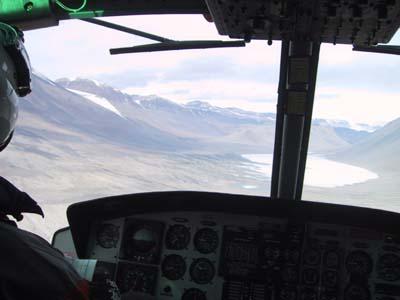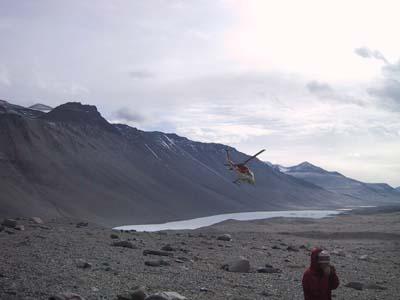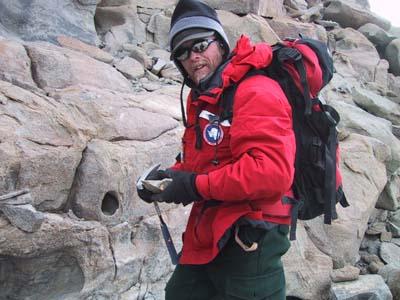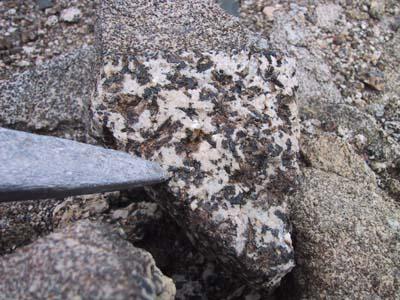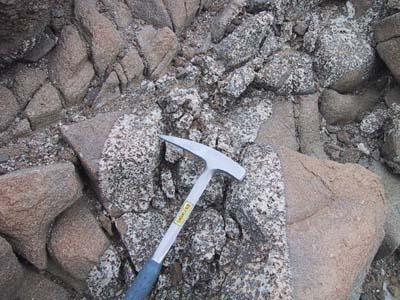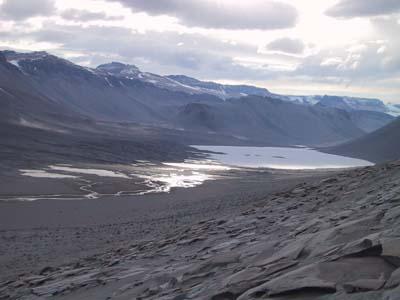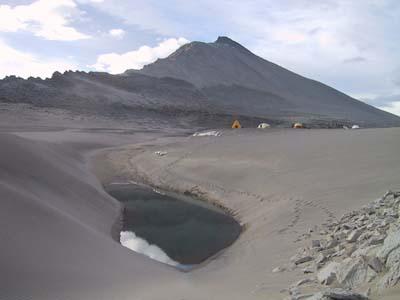
|
17 January, 2003Dais We return to the Dais today to collect samples for later analysis of the feeder system in this region. We take samples at 5 meter intervals up the side of the Dais. This takes about four hours once we begin. Near the upper portion of the sampling we come across a segregation of clinopyroxene (CPX) crystals surrounded by pyroxenite. CPX is a mineral generally associated with diorites and basalts. It consists mostly of calcium, magnesium, iron, silicon, and aluminum. We have lunch while we're sampling and a snack later. By the time we are down the side of the Dais it is about 4pm. We find out that there is some sort of trouble with the helo that will pick us up and ha we will have to wait a couple of hours. It's getting pretty cold so we decide to start hiking back to Bull Pass in order to stay warm. Bull Pass is about 8 miles if we could go in a straight line but after a couple hours we could be picked up so we leave our rock samples and some equipment at the Dais to be picked up at another thime. It's a beautiful walk back by Lake Vanda, a frozen-over lake at the bottom of Wright Valley. After a few hours we learn that there has been some type of helo incident and that it may be some time before we can be picked up so we just keep going. After about six hours we are rewarded with the site of our base camp on the other side of a ridge a third of the way up the side of Wright Valley. It's about 11pm - a long day. By the way, if you've sent me an email lately and I haven't responded, it's not because I'm ignoring you. We don't have email or internet here in Bull Pass. I've been sending my journals back to McMurdo where Karen Joyce and Robbie Liben have graciously volunteered to post them for me. Antarctica Tidbits: One of the biggest icebergs ever (possibly the biggest iceberg ever) broke free from the Ross ice shelf in Antarctica in 2000. It was 295km (183 miles) long and 37km (23 miles) wide, with a surface area of 11,000 sq km (4,250 square miles) - similar in size to The Gambia, Qatar, The Bahamas, or Connecticut - above water - and 10 times bigger below. It has been estimated that during the feeding season in Antarctica, a full grown blue whale eats about 40 million krill per day (krill are small shrimp-like creatures), that's 3600 kg or 4 tons - every day for 6 months. The daily intake would feed a human for about 4 years! (if you could stomach it, krill may be nutritious but they're not very nice as people food - fortunately for the whales!). Since the Antarctic convergence arose about 20 million years ago, there has been very little exchange of fish or other marine life in either direction. Antarctic fish have lived at between +2°C and -2°C for 5 million years (-2°C is the freezing point of sea water). They are therefore the best cold adapted animals that there are on the planet - now or ever. Source: http://www.coolantarctica.com/Antarctica%20fact%20file/fascinating_facts_about_antar.htm
Contact the TEA in the field at . If you cannot connect through your browser, copy the TEA's e-mail address in the "To:" line of your favorite e-mail package. |




